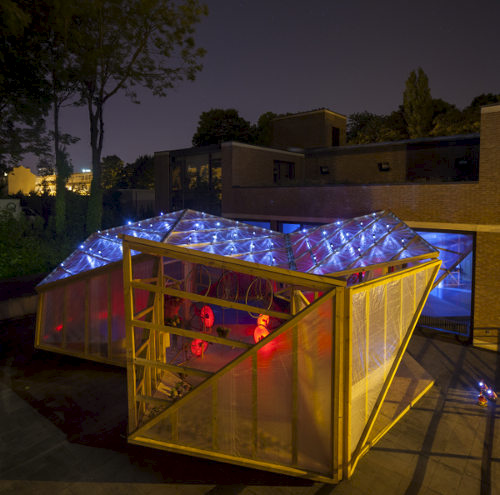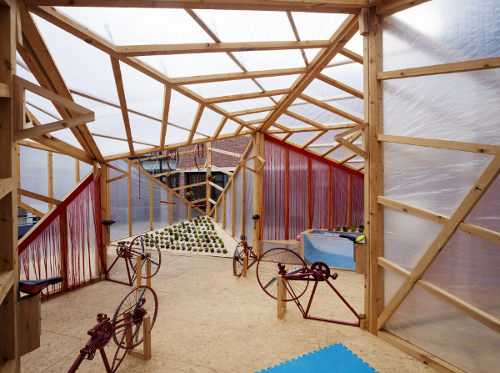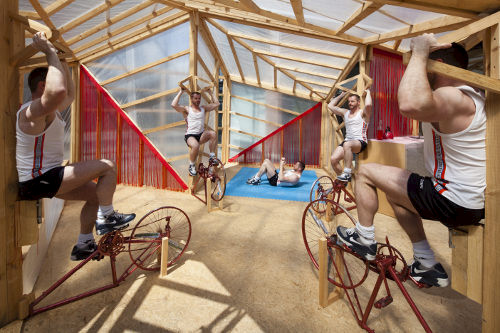
JF Kit House
The JF·Kit House (Jane Fonda Kit House) renders a possible future where citizens produce part of their domestic energy requirements with with their own muscles, with their dayly physical activities. Thinking of any stage of energy development entails "reinventing" a new culture, and the body is a central battlefield in the articulation of sustainable controversies where this new culture 'embodies'.

Interior of JF Kit House 01
Conceived as an experimental "house of the future", the Jane Fonda Kit House departs from those grand architectural visions that have attempted to offer normative or desirable models, to offer instead a rhetorical artefact that seeks to interrogate hegemonic and taken for granted models of sustainability and green architecture.
This exploration takes place through four different, although tightly interconnected, scales of sustainability. First, the JF-Kit House explores the urban scale by offering an infinitely replicable model for a self-sufficient and off-the-grid 'parasitic' structure that can be added onto existing rooftops and walls (such as CIVA's roof terrace). The JF-Kit House thus renders the image of a future in which it is possible to augment urban density while maximizing energy consumption through the invasion of these parasites. Second, the prototype explores the architectural scale of sustainability by investigating how energy efficiency criteria can be incorporated into architectural practice itself-for example, through the design of the house as an active energy production unit.

Interior of JF Kit House 02
Third, the JF-Kit House investigates the economic scale of sustainability by offering a model to 'unblackbox' domestic energy consumption patterns through the use of different display devices and monitoring tools-like smart energy meters or saving energy devices, community energy networks, and through the implementation of 'energy mortgages' that use energy savings to pay off house mortgages. And fourth, the houses addresses the oft-neglected socio-cultural scale of sustainability by revealing how the three previous scales of sustainability remain ineffective unless they are followed by the inscription of a new set of habits and practices into the body politik. The house brings the metaphor of the body politik to its literal extreme by showing how the achievement of sustainable futures require the production of new bodies: bodies that can be productively mobilized within the domestic space as active agents in the process of energy production.
The JF-Kit House reveals the body as a critical passage point and a central battlefield in the articulation of sustainable futures. Tthe ideal citizen as an individual who can satisfy all her domestic energy needs through her own bodily exercise in this House. Through the radicalization of this model, the JF-Kit House aims to open a debate about the kind of bodies that are required for political participation and for the proper functioning of sustainable economic systems.

Exercise in JF Kit House
By revealing the home as one of the key spaces where the body politik is being continually made and remade, the JF-Kit House invites us to go beyond those modern distinctions that have separated the public from the private, or political actions from everyday practices. The JF-Kit House envisages a future in which the private space of the home is transformed into a sui generis political space, that is, into a place in which it is possible to engage with larger political projects, like sustainable societies or low-carbon economy, through seemingly mundane choices and practices. It does so by showing, for example, how ordinary domestic devices-like 'domestic fitness furnitures' can be productively employed to raise awareness of the energetic and economic costs involved in mundane activities-like cooking, or watching TV, watering the plants, swaying in a rocking chair, or working at home, and to induce, in so doing, other forms of consumption and political behaviours.
As an experimental exercise in the underexplored field of architectural teratology, the JF-Kit House does not aim to offer the solace of utopian promises or the assured comfort of normative models. It simply aims to create a plausible monstrosity that offers a polemical prototype to extend the sphere of the body politik beyond its traditional formats and sites.
About the exhibition
Dates: 10 Sep - 8 Oct 2013
Venue: Plaza outside GDMoA
Artist: ELII
Project Manager: Lin Jieli
Organizers: GDMoA & CIVA
Co-organizer: the Consulate-General of Belgium in Guangzhou
Tel: 020-87351468
Add: 38 Yanyu lu, Ersha dao, Yuexiu qu, Guangzhou
Courtesy of the artist and Guangdong Museum of Art, for further information please visit www.gdmoa.org.




























